Gender, Emotions & Customer Buying Decisions in Fashion - Dar Al Hekma
VerifiedAdded on 2023/05/28
|25
|5007
|314
AI Summary
This research paper, submitted to Dar Al Hekma University, investigates the impact of gender and emotional experiences on customer buying decisions in the fashion industry. It explores how gender, as a social construct, influences fashion preferences and purchasing behaviors. The study also examines the role of emotional attachment to retail stores and how store ambience affects customer perception and shopping habits. Key findings indicate that men favor organized stores, while quality, price, and merchandise selection are crucial factors for all customers. The research concludes that emotional connection to a store can significantly drive repeat purchases.
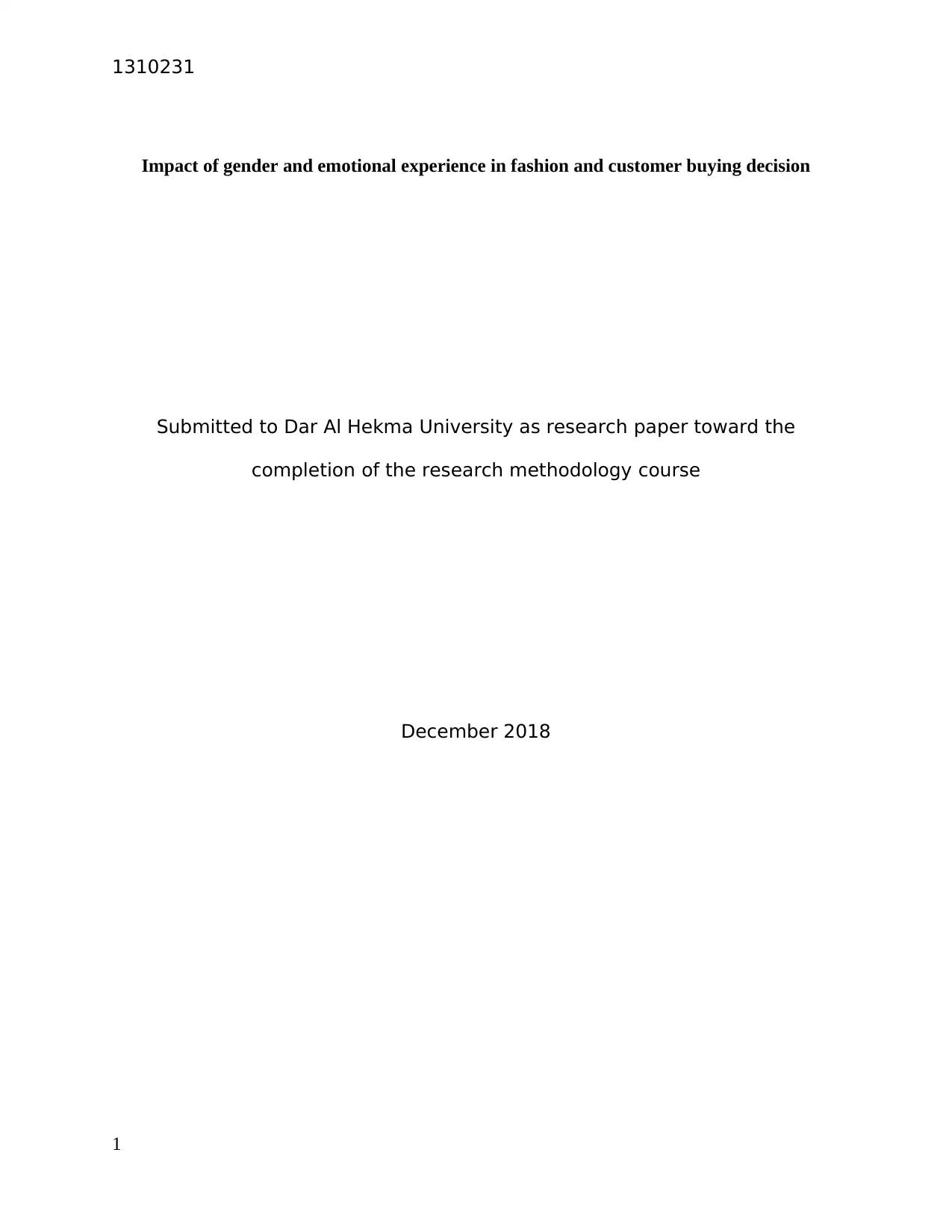
1310231
Impact of gender and emotional experience in fashion and customer buying decision
Submitted to Dar Al Hekma University as research paper toward the
completion of the research methodology course
December 2018
1
Impact of gender and emotional experience in fashion and customer buying decision
Submitted to Dar Al Hekma University as research paper toward the
completion of the research methodology course
December 2018
1
Paraphrase This Document
Need a fresh take? Get an instant paraphrase of this document with our AI Paraphraser
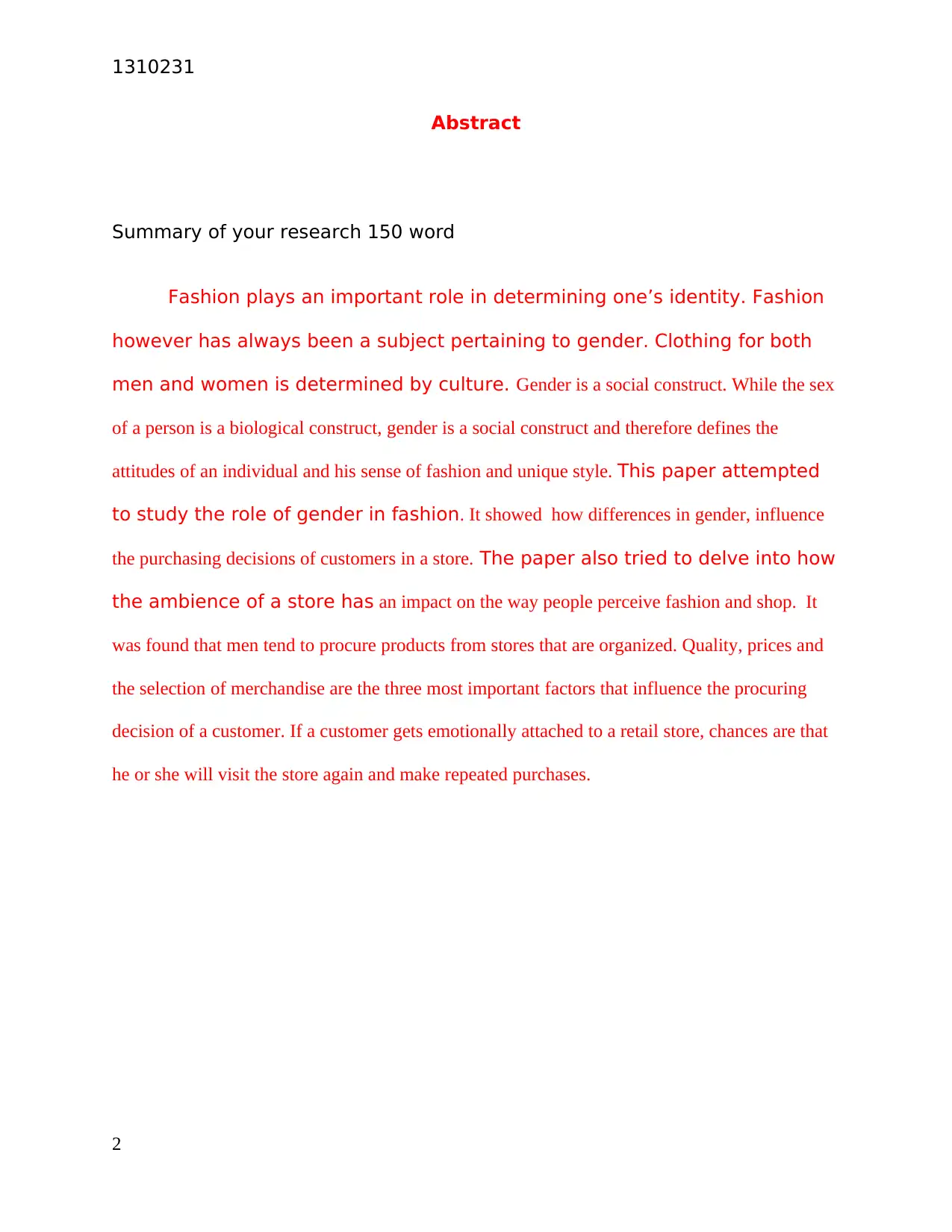
1310231
Abstract
Summary of your research 150 word
Fashion plays an important role in determining one’s identity. Fashion
however has always been a subject pertaining to gender. Clothing for both
men and women is determined by culture. Gender is a social construct. While the sex
of a person is a biological construct, gender is a social construct and therefore defines the
attitudes of an individual and his sense of fashion and unique style. This paper attempted
to study the role of gender in fashion. It showed how differences in gender, influence
the purchasing decisions of customers in a store. The paper also tried to delve into how
the ambience of a store has an impact on the way people perceive fashion and shop. It
was found that men tend to procure products from stores that are organized. Quality, prices and
the selection of merchandise are the three most important factors that influence the procuring
decision of a customer. If a customer gets emotionally attached to a retail store, chances are that
he or she will visit the store again and make repeated purchases.
2
Abstract
Summary of your research 150 word
Fashion plays an important role in determining one’s identity. Fashion
however has always been a subject pertaining to gender. Clothing for both
men and women is determined by culture. Gender is a social construct. While the sex
of a person is a biological construct, gender is a social construct and therefore defines the
attitudes of an individual and his sense of fashion and unique style. This paper attempted
to study the role of gender in fashion. It showed how differences in gender, influence
the purchasing decisions of customers in a store. The paper also tried to delve into how
the ambience of a store has an impact on the way people perceive fashion and shop. It
was found that men tend to procure products from stores that are organized. Quality, prices and
the selection of merchandise are the three most important factors that influence the procuring
decision of a customer. If a customer gets emotionally attached to a retail store, chances are that
he or she will visit the store again and make repeated purchases.
2

1310231
Acknowledgements
I would like to thank all my professors for their guidance, support, feedback and cooperation in
writing this paper. I would also like to thank all the participants who supported me in my work
and participated in the interviews. Last but not the least I would like to thank my family for
always supporting me.
3
Acknowledgements
I would like to thank all my professors for their guidance, support, feedback and cooperation in
writing this paper. I would also like to thank all the participants who supported me in my work
and participated in the interviews. Last but not the least I would like to thank my family for
always supporting me.
3
⊘ This is a preview!⊘
Do you want full access?
Subscribe today to unlock all pages.

Trusted by 1+ million students worldwide
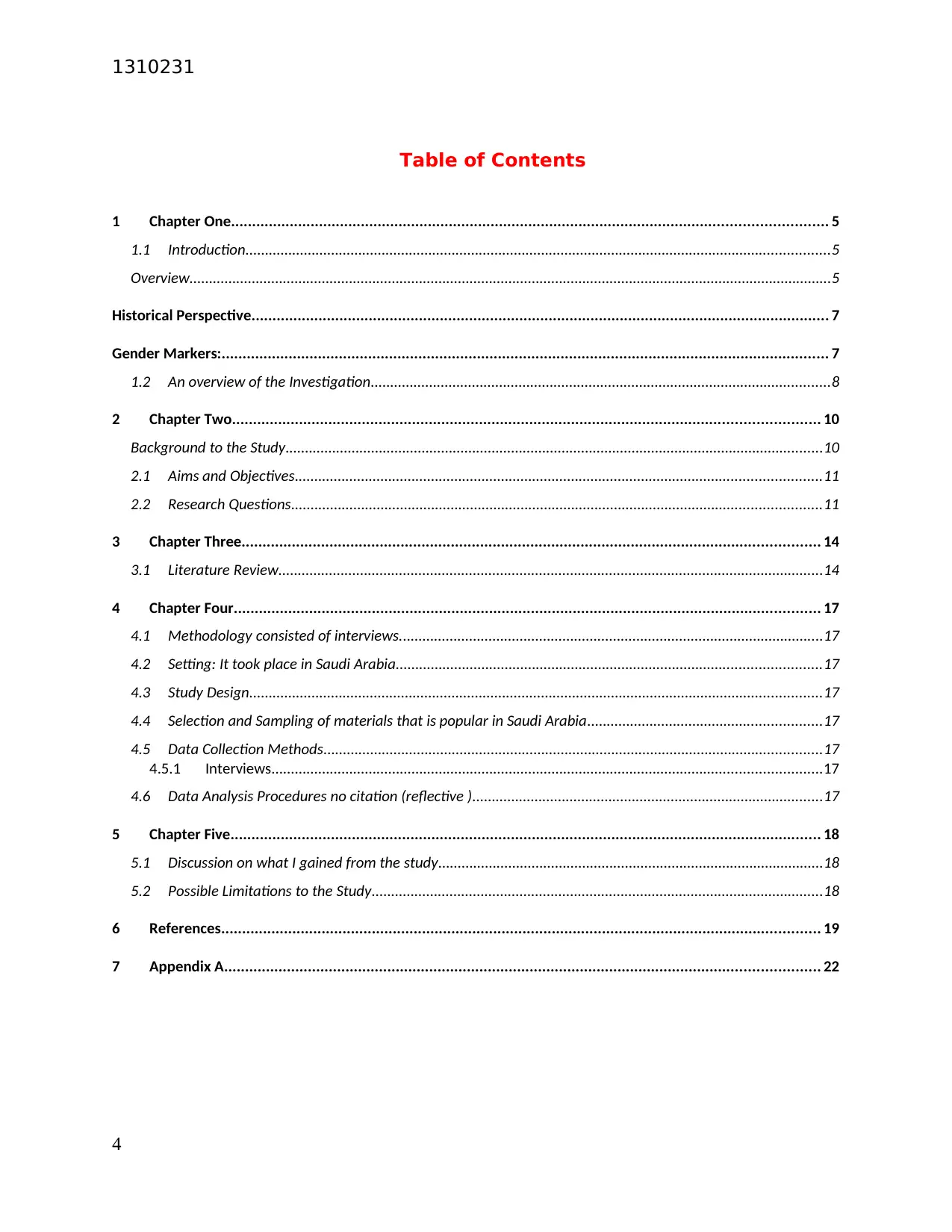
1310231
Table of Contents
1 Chapter One.............................................................................................................................................. 5
1.1 Introduction......................................................................................................................................................5
Overview.....................................................................................................................................................................5
Historical Perspective.......................................................................................................................................... 7
Gender Markers:................................................................................................................................................. 7
1.2 An overview of the Investigation......................................................................................................................8
2 Chapter Two............................................................................................................................................ 10
Background to the Study..........................................................................................................................................10
2.1 Aims and Objectives.......................................................................................................................................11
2.2 Research Questions........................................................................................................................................11
3 Chapter Three.......................................................................................................................................... 14
3.1 Literature Review............................................................................................................................................14
4 Chapter Four............................................................................................................................................ 17
4.1 Methodology consisted of interviews.............................................................................................................17
4.2 Setting: It took place in Saudi Arabia.............................................................................................................17
4.3 Study Design...................................................................................................................................................17
4.4 Selection and Sampling of materials that is popular in Saudi Arabia............................................................17
4.5 Data Collection Methods................................................................................................................................17
4.5.1 Interviews.............................................................................................................................................17
4.6 Data Analysis Procedures no citation (reflective )..........................................................................................17
5 Chapter Five............................................................................................................................................. 18
5.1 Discussion on what I gained from the study...................................................................................................18
5.2 Possible Limitations to the Study....................................................................................................................18
6 References............................................................................................................................................... 19
7 Appendix A.............................................................................................................................................. 22
4
Table of Contents
1 Chapter One.............................................................................................................................................. 5
1.1 Introduction......................................................................................................................................................5
Overview.....................................................................................................................................................................5
Historical Perspective.......................................................................................................................................... 7
Gender Markers:................................................................................................................................................. 7
1.2 An overview of the Investigation......................................................................................................................8
2 Chapter Two............................................................................................................................................ 10
Background to the Study..........................................................................................................................................10
2.1 Aims and Objectives.......................................................................................................................................11
2.2 Research Questions........................................................................................................................................11
3 Chapter Three.......................................................................................................................................... 14
3.1 Literature Review............................................................................................................................................14
4 Chapter Four............................................................................................................................................ 17
4.1 Methodology consisted of interviews.............................................................................................................17
4.2 Setting: It took place in Saudi Arabia.............................................................................................................17
4.3 Study Design...................................................................................................................................................17
4.4 Selection and Sampling of materials that is popular in Saudi Arabia............................................................17
4.5 Data Collection Methods................................................................................................................................17
4.5.1 Interviews.............................................................................................................................................17
4.6 Data Analysis Procedures no citation (reflective )..........................................................................................17
5 Chapter Five............................................................................................................................................. 18
5.1 Discussion on what I gained from the study...................................................................................................18
5.2 Possible Limitations to the Study....................................................................................................................18
6 References............................................................................................................................................... 19
7 Appendix A.............................................................................................................................................. 22
4
Paraphrase This Document
Need a fresh take? Get an instant paraphrase of this document with our AI Paraphraser
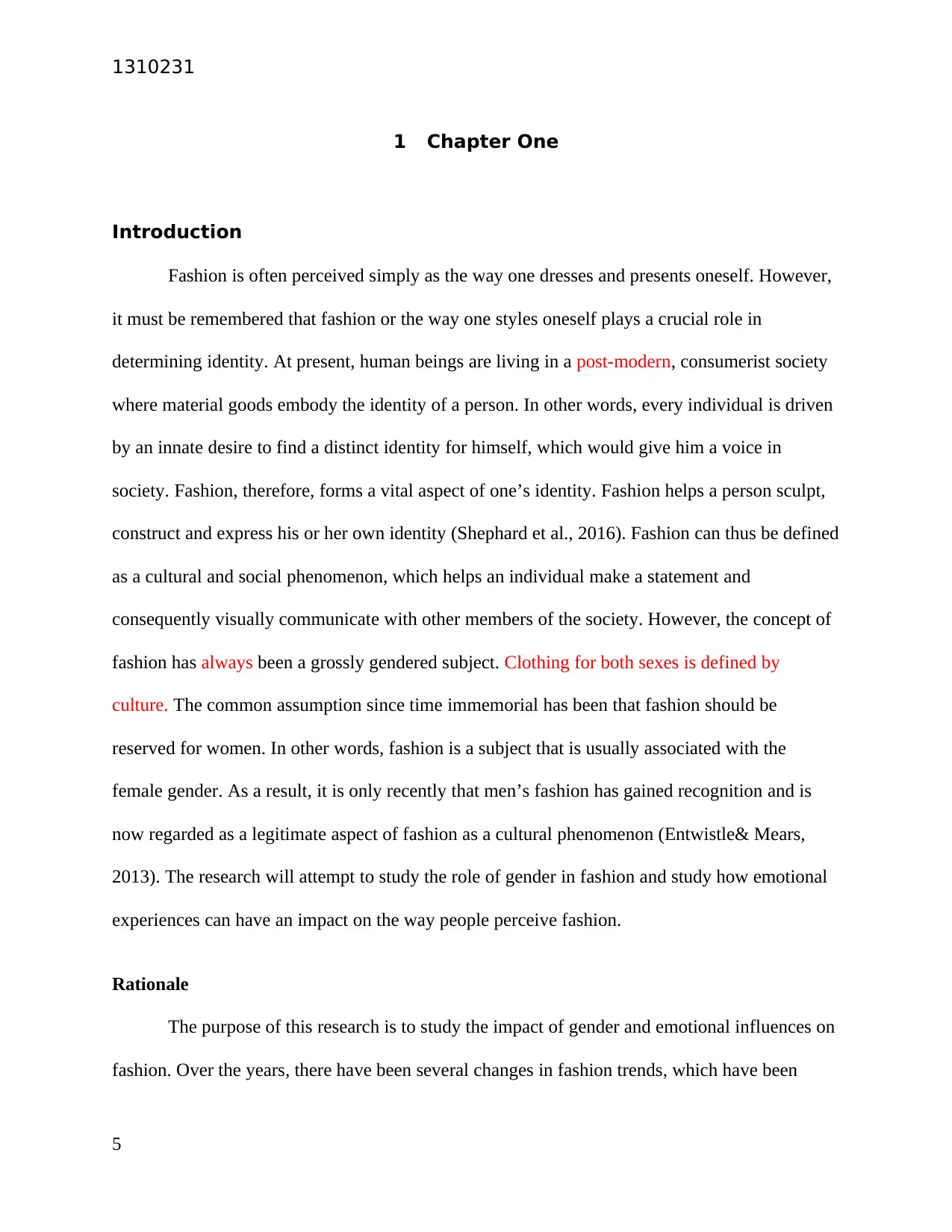
1310231
1 Chapter One
Introduction
Fashion is often perceived simply as the way one dresses and presents oneself. However,
it must be remembered that fashion or the way one styles oneself plays a crucial role in
determining identity. At present, human beings are living in a post-modern, consumerist society
where material goods embody the identity of a person. In other words, every individual is driven
by an innate desire to find a distinct identity for himself, which would give him a voice in
society. Fashion, therefore, forms a vital aspect of one’s identity. Fashion helps a person sculpt,
construct and express his or her own identity (Shephard et al., 2016). Fashion can thus be defined
as a cultural and social phenomenon, which helps an individual make a statement and
consequently visually communicate with other members of the society. However, the concept of
fashion has always been a grossly gendered subject. Clothing for both sexes is defined by
culture. The common assumption since time immemorial has been that fashion should be
reserved for women. In other words, fashion is a subject that is usually associated with the
female gender. As a result, it is only recently that men’s fashion has gained recognition and is
now regarded as a legitimate aspect of fashion as a cultural phenomenon (Entwistle& Mears,
2013). The research will attempt to study the role of gender in fashion and study how emotional
experiences can have an impact on the way people perceive fashion.
Rationale
The purpose of this research is to study the impact of gender and emotional influences on
fashion. Over the years, there have been several changes in fashion trends, which have been
5
1 Chapter One
Introduction
Fashion is often perceived simply as the way one dresses and presents oneself. However,
it must be remembered that fashion or the way one styles oneself plays a crucial role in
determining identity. At present, human beings are living in a post-modern, consumerist society
where material goods embody the identity of a person. In other words, every individual is driven
by an innate desire to find a distinct identity for himself, which would give him a voice in
society. Fashion, therefore, forms a vital aspect of one’s identity. Fashion helps a person sculpt,
construct and express his or her own identity (Shephard et al., 2016). Fashion can thus be defined
as a cultural and social phenomenon, which helps an individual make a statement and
consequently visually communicate with other members of the society. However, the concept of
fashion has always been a grossly gendered subject. Clothing for both sexes is defined by
culture. The common assumption since time immemorial has been that fashion should be
reserved for women. In other words, fashion is a subject that is usually associated with the
female gender. As a result, it is only recently that men’s fashion has gained recognition and is
now regarded as a legitimate aspect of fashion as a cultural phenomenon (Entwistle& Mears,
2013). The research will attempt to study the role of gender in fashion and study how emotional
experiences can have an impact on the way people perceive fashion.
Rationale
The purpose of this research is to study the impact of gender and emotional influences on
fashion. Over the years, there have been several changes in fashion trends, which have been
5
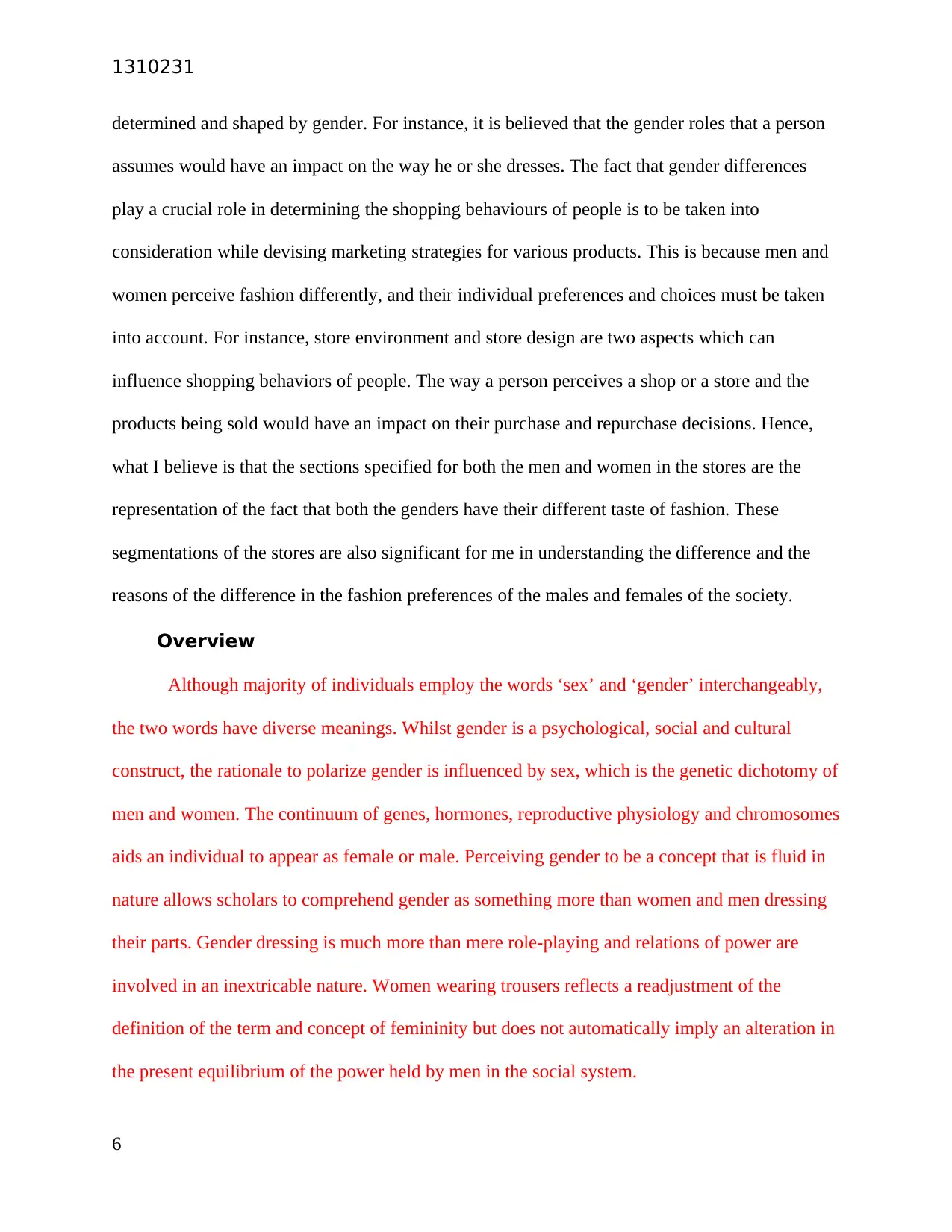
1310231
determined and shaped by gender. For instance, it is believed that the gender roles that a person
assumes would have an impact on the way he or she dresses. The fact that gender differences
play a crucial role in determining the shopping behaviours of people is to be taken into
consideration while devising marketing strategies for various products. This is because men and
women perceive fashion differently, and their individual preferences and choices must be taken
into account. For instance, store environment and store design are two aspects which can
influence shopping behaviors of people. The way a person perceives a shop or a store and the
products being sold would have an impact on their purchase and repurchase decisions. Hence,
what I believe is that the sections specified for both the men and women in the stores are the
representation of the fact that both the genders have their different taste of fashion. These
segmentations of the stores are also significant for me in understanding the difference and the
reasons of the difference in the fashion preferences of the males and females of the society.
Overview
Although majority of individuals employ the words ‘sex’ and ‘gender’ interchangeably,
the two words have diverse meanings. Whilst gender is a psychological, social and cultural
construct, the rationale to polarize gender is influenced by sex, which is the genetic dichotomy of
men and women. The continuum of genes, hormones, reproductive physiology and chromosomes
aids an individual to appear as female or male. Perceiving gender to be a concept that is fluid in
nature allows scholars to comprehend gender as something more than women and men dressing
their parts. Gender dressing is much more than mere role-playing and relations of power are
involved in an inextricable nature. Women wearing trousers reflects a readjustment of the
definition of the term and concept of femininity but does not automatically imply an alteration in
the present equilibrium of the power held by men in the social system.
6
determined and shaped by gender. For instance, it is believed that the gender roles that a person
assumes would have an impact on the way he or she dresses. The fact that gender differences
play a crucial role in determining the shopping behaviours of people is to be taken into
consideration while devising marketing strategies for various products. This is because men and
women perceive fashion differently, and their individual preferences and choices must be taken
into account. For instance, store environment and store design are two aspects which can
influence shopping behaviors of people. The way a person perceives a shop or a store and the
products being sold would have an impact on their purchase and repurchase decisions. Hence,
what I believe is that the sections specified for both the men and women in the stores are the
representation of the fact that both the genders have their different taste of fashion. These
segmentations of the stores are also significant for me in understanding the difference and the
reasons of the difference in the fashion preferences of the males and females of the society.
Overview
Although majority of individuals employ the words ‘sex’ and ‘gender’ interchangeably,
the two words have diverse meanings. Whilst gender is a psychological, social and cultural
construct, the rationale to polarize gender is influenced by sex, which is the genetic dichotomy of
men and women. The continuum of genes, hormones, reproductive physiology and chromosomes
aids an individual to appear as female or male. Perceiving gender to be a concept that is fluid in
nature allows scholars to comprehend gender as something more than women and men dressing
their parts. Gender dressing is much more than mere role-playing and relations of power are
involved in an inextricable nature. Women wearing trousers reflects a readjustment of the
definition of the term and concept of femininity but does not automatically imply an alteration in
the present equilibrium of the power held by men in the social system.
6
⊘ This is a preview!⊘
Do you want full access?
Subscribe today to unlock all pages.

Trusted by 1+ million students worldwide
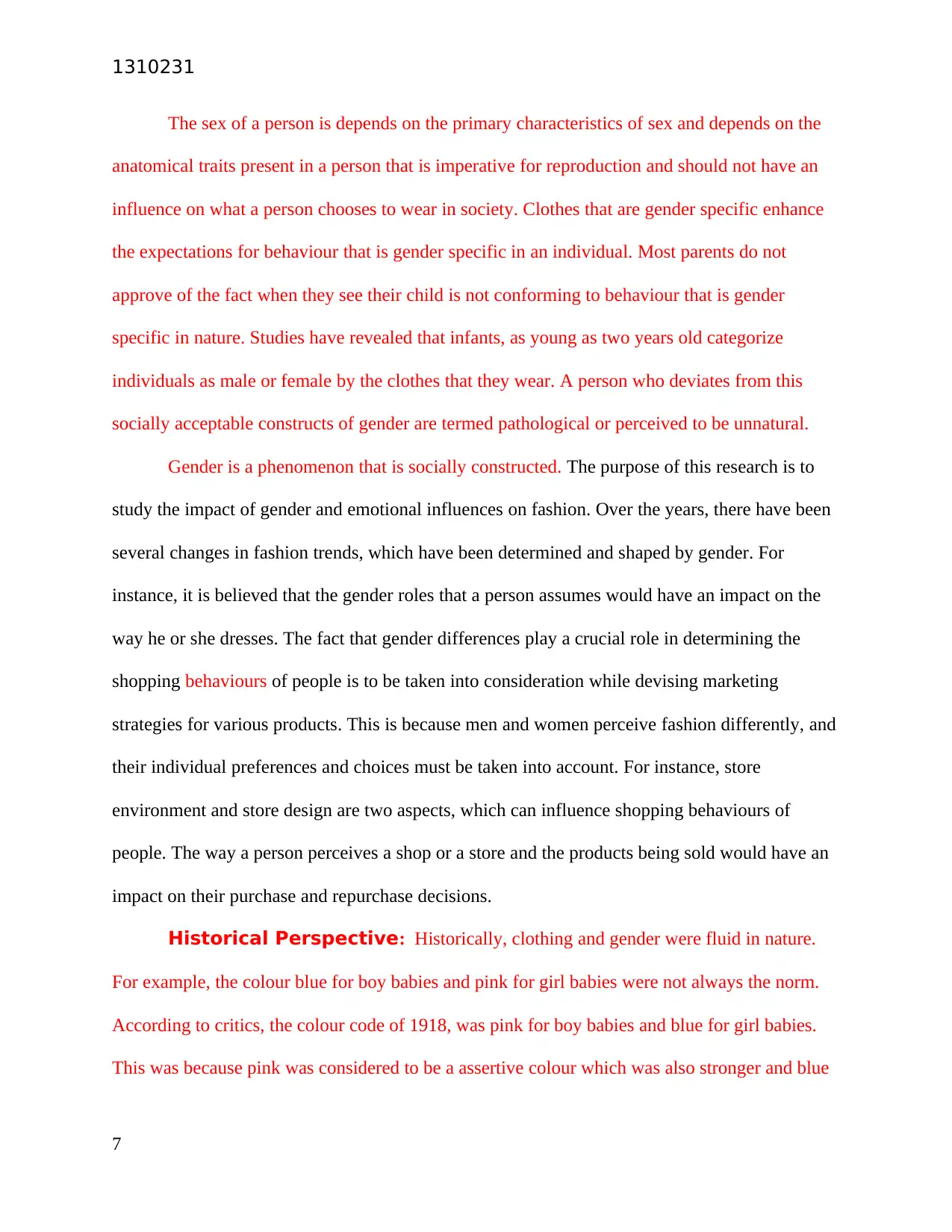
1310231
The sex of a person is depends on the primary characteristics of sex and depends on the
anatomical traits present in a person that is imperative for reproduction and should not have an
influence on what a person chooses to wear in society. Clothes that are gender specific enhance
the expectations for behaviour that is gender specific in an individual. Most parents do not
approve of the fact when they see their child is not conforming to behaviour that is gender
specific in nature. Studies have revealed that infants, as young as two years old categorize
individuals as male or female by the clothes that they wear. A person who deviates from this
socially acceptable constructs of gender are termed pathological or perceived to be unnatural.
Gender is a phenomenon that is socially constructed. The purpose of this research is to
study the impact of gender and emotional influences on fashion. Over the years, there have been
several changes in fashion trends, which have been determined and shaped by gender. For
instance, it is believed that the gender roles that a person assumes would have an impact on the
way he or she dresses. The fact that gender differences play a crucial role in determining the
shopping behaviours of people is to be taken into consideration while devising marketing
strategies for various products. This is because men and women perceive fashion differently, and
their individual preferences and choices must be taken into account. For instance, store
environment and store design are two aspects, which can influence shopping behaviours of
people. The way a person perceives a shop or a store and the products being sold would have an
impact on their purchase and repurchase decisions.
Historical Perspective: Historically, clothing and gender were fluid in nature.
For example, the colour blue for boy babies and pink for girl babies were not always the norm.
According to critics, the colour code of 1918, was pink for boy babies and blue for girl babies.
This was because pink was considered to be a assertive colour which was also stronger and blue
7
The sex of a person is depends on the primary characteristics of sex and depends on the
anatomical traits present in a person that is imperative for reproduction and should not have an
influence on what a person chooses to wear in society. Clothes that are gender specific enhance
the expectations for behaviour that is gender specific in an individual. Most parents do not
approve of the fact when they see their child is not conforming to behaviour that is gender
specific in nature. Studies have revealed that infants, as young as two years old categorize
individuals as male or female by the clothes that they wear. A person who deviates from this
socially acceptable constructs of gender are termed pathological or perceived to be unnatural.
Gender is a phenomenon that is socially constructed. The purpose of this research is to
study the impact of gender and emotional influences on fashion. Over the years, there have been
several changes in fashion trends, which have been determined and shaped by gender. For
instance, it is believed that the gender roles that a person assumes would have an impact on the
way he or she dresses. The fact that gender differences play a crucial role in determining the
shopping behaviours of people is to be taken into consideration while devising marketing
strategies for various products. This is because men and women perceive fashion differently, and
their individual preferences and choices must be taken into account. For instance, store
environment and store design are two aspects, which can influence shopping behaviours of
people. The way a person perceives a shop or a store and the products being sold would have an
impact on their purchase and repurchase decisions.
Historical Perspective: Historically, clothing and gender were fluid in nature.
For example, the colour blue for boy babies and pink for girl babies were not always the norm.
According to critics, the colour code of 1918, was pink for boy babies and blue for girl babies.
This was because pink was considered to be a assertive colour which was also stronger and blue
7
Paraphrase This Document
Need a fresh take? Get an instant paraphrase of this document with our AI Paraphraser
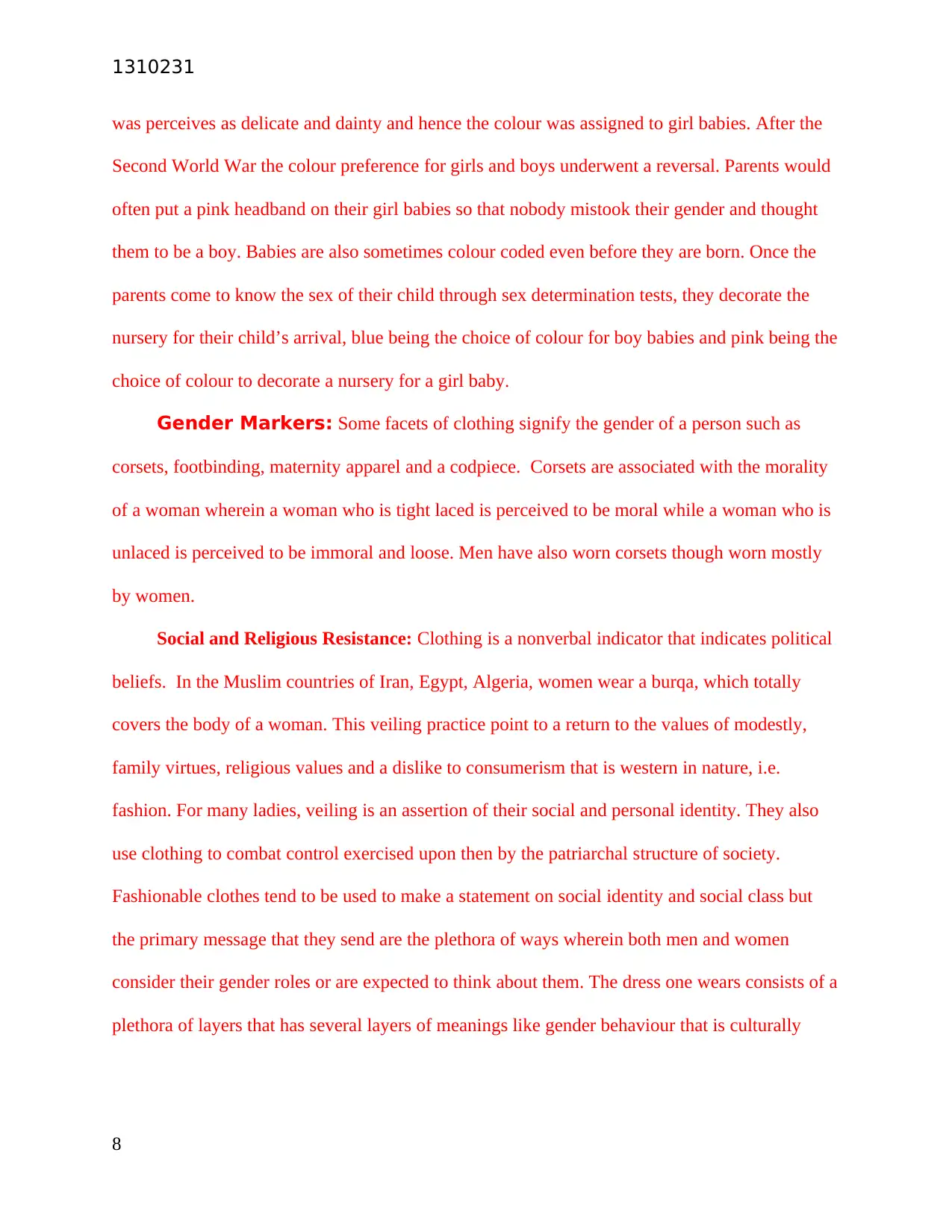
1310231
was perceives as delicate and dainty and hence the colour was assigned to girl babies. After the
Second World War the colour preference for girls and boys underwent a reversal. Parents would
often put a pink headband on their girl babies so that nobody mistook their gender and thought
them to be a boy. Babies are also sometimes colour coded even before they are born. Once the
parents come to know the sex of their child through sex determination tests, they decorate the
nursery for their child’s arrival, blue being the choice of colour for boy babies and pink being the
choice of colour to decorate a nursery for a girl baby.
Gender Markers: Some facets of clothing signify the gender of a person such as
corsets, footbinding, maternity apparel and a codpiece. Corsets are associated with the morality
of a woman wherein a woman who is tight laced is perceived to be moral while a woman who is
unlaced is perceived to be immoral and loose. Men have also worn corsets though worn mostly
by women.
Social and Religious Resistance: Clothing is a nonverbal indicator that indicates political
beliefs. In the Muslim countries of Iran, Egypt, Algeria, women wear a burqa, which totally
covers the body of a woman. This veiling practice point to a return to the values of modestly,
family virtues, religious values and a dislike to consumerism that is western in nature, i.e.
fashion. For many ladies, veiling is an assertion of their social and personal identity. They also
use clothing to combat control exercised upon then by the patriarchal structure of society.
Fashionable clothes tend to be used to make a statement on social identity and social class but
the primary message that they send are the plethora of ways wherein both men and women
consider their gender roles or are expected to think about them. The dress one wears consists of a
plethora of layers that has several layers of meanings like gender behaviour that is culturally
8
was perceives as delicate and dainty and hence the colour was assigned to girl babies. After the
Second World War the colour preference for girls and boys underwent a reversal. Parents would
often put a pink headband on their girl babies so that nobody mistook their gender and thought
them to be a boy. Babies are also sometimes colour coded even before they are born. Once the
parents come to know the sex of their child through sex determination tests, they decorate the
nursery for their child’s arrival, blue being the choice of colour for boy babies and pink being the
choice of colour to decorate a nursery for a girl baby.
Gender Markers: Some facets of clothing signify the gender of a person such as
corsets, footbinding, maternity apparel and a codpiece. Corsets are associated with the morality
of a woman wherein a woman who is tight laced is perceived to be moral while a woman who is
unlaced is perceived to be immoral and loose. Men have also worn corsets though worn mostly
by women.
Social and Religious Resistance: Clothing is a nonverbal indicator that indicates political
beliefs. In the Muslim countries of Iran, Egypt, Algeria, women wear a burqa, which totally
covers the body of a woman. This veiling practice point to a return to the values of modestly,
family virtues, religious values and a dislike to consumerism that is western in nature, i.e.
fashion. For many ladies, veiling is an assertion of their social and personal identity. They also
use clothing to combat control exercised upon then by the patriarchal structure of society.
Fashionable clothes tend to be used to make a statement on social identity and social class but
the primary message that they send are the plethora of ways wherein both men and women
consider their gender roles or are expected to think about them. The dress one wears consists of a
plethora of layers that has several layers of meanings like gender behaviour that is culturally
8
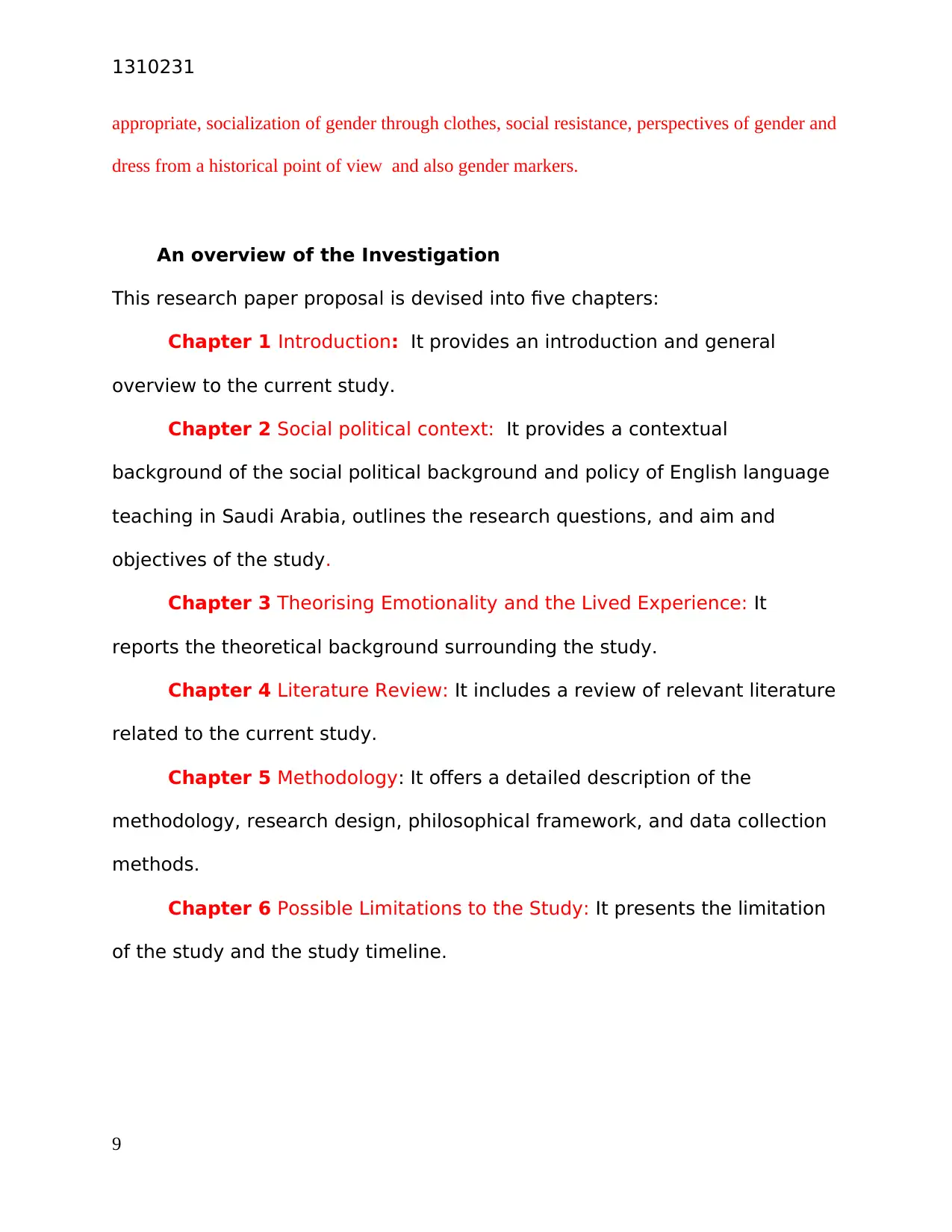
1310231
appropriate, socialization of gender through clothes, social resistance, perspectives of gender and
dress from a historical point of view and also gender markers.
An overview of the Investigation
This research paper proposal is devised into five chapters:
Chapter 1 Introduction: It provides an introduction and general
overview to the current study.
Chapter 2 Social political context: It provides a contextual
background of the social political background and policy of English language
teaching in Saudi Arabia, outlines the research questions, and aim and
objectives of the study.
Chapter 3 Theorising Emotionality and the Lived Experience: It
reports the theoretical background surrounding the study.
Chapter 4 Literature Review: It includes a review of relevant literature
related to the current study.
Chapter 5 Methodology: It offers a detailed description of the
methodology, research design, philosophical framework, and data collection
methods.
Chapter 6 Possible Limitations to the Study: It presents the limitation
of the study and the study timeline.
9
appropriate, socialization of gender through clothes, social resistance, perspectives of gender and
dress from a historical point of view and also gender markers.
An overview of the Investigation
This research paper proposal is devised into five chapters:
Chapter 1 Introduction: It provides an introduction and general
overview to the current study.
Chapter 2 Social political context: It provides a contextual
background of the social political background and policy of English language
teaching in Saudi Arabia, outlines the research questions, and aim and
objectives of the study.
Chapter 3 Theorising Emotionality and the Lived Experience: It
reports the theoretical background surrounding the study.
Chapter 4 Literature Review: It includes a review of relevant literature
related to the current study.
Chapter 5 Methodology: It offers a detailed description of the
methodology, research design, philosophical framework, and data collection
methods.
Chapter 6 Possible Limitations to the Study: It presents the limitation
of the study and the study timeline.
9
⊘ This is a preview!⊘
Do you want full access?
Subscribe today to unlock all pages.

Trusted by 1+ million students worldwide
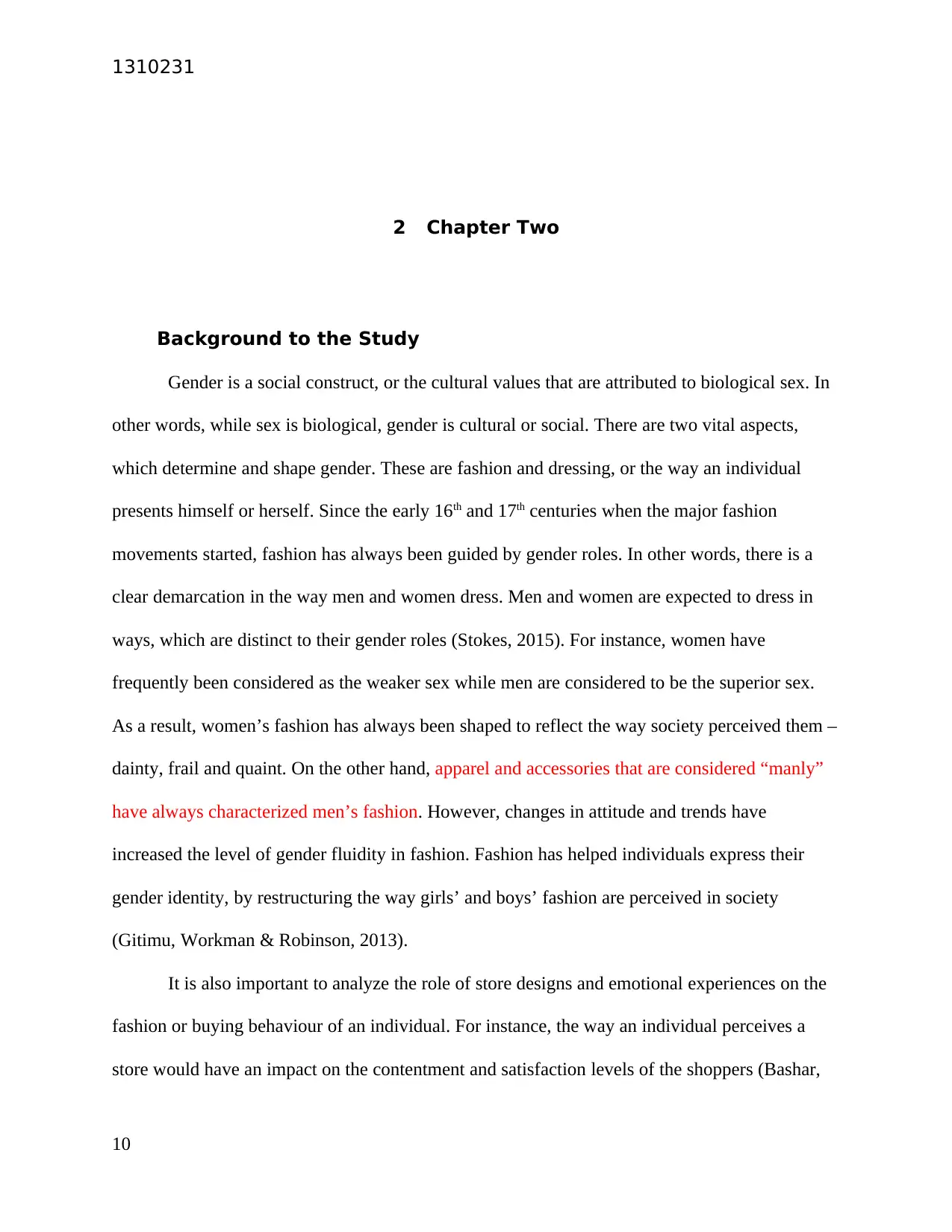
1310231
2 Chapter Two
Background to the Study
Gender is a social construct, or the cultural values that are attributed to biological sex. In
other words, while sex is biological, gender is cultural or social. There are two vital aspects,
which determine and shape gender. These are fashion and dressing, or the way an individual
presents himself or herself. Since the early 16th and 17th centuries when the major fashion
movements started, fashion has always been guided by gender roles. In other words, there is a
clear demarcation in the way men and women dress. Men and women are expected to dress in
ways, which are distinct to their gender roles (Stokes, 2015). For instance, women have
frequently been considered as the weaker sex while men are considered to be the superior sex.
As a result, women’s fashion has always been shaped to reflect the way society perceived them –
dainty, frail and quaint. On the other hand, apparel and accessories that are considered “manly”
have always characterized men’s fashion. However, changes in attitude and trends have
increased the level of gender fluidity in fashion. Fashion has helped individuals express their
gender identity, by restructuring the way girls’ and boys’ fashion are perceived in society
(Gitimu, Workman & Robinson, 2013).
It is also important to analyze the role of store designs and emotional experiences on the
fashion or buying behaviour of an individual. For instance, the way an individual perceives a
store would have an impact on the contentment and satisfaction levels of the shoppers (Bashar,
10
2 Chapter Two
Background to the Study
Gender is a social construct, or the cultural values that are attributed to biological sex. In
other words, while sex is biological, gender is cultural or social. There are two vital aspects,
which determine and shape gender. These are fashion and dressing, or the way an individual
presents himself or herself. Since the early 16th and 17th centuries when the major fashion
movements started, fashion has always been guided by gender roles. In other words, there is a
clear demarcation in the way men and women dress. Men and women are expected to dress in
ways, which are distinct to their gender roles (Stokes, 2015). For instance, women have
frequently been considered as the weaker sex while men are considered to be the superior sex.
As a result, women’s fashion has always been shaped to reflect the way society perceived them –
dainty, frail and quaint. On the other hand, apparel and accessories that are considered “manly”
have always characterized men’s fashion. However, changes in attitude and trends have
increased the level of gender fluidity in fashion. Fashion has helped individuals express their
gender identity, by restructuring the way girls’ and boys’ fashion are perceived in society
(Gitimu, Workman & Robinson, 2013).
It is also important to analyze the role of store designs and emotional experiences on the
fashion or buying behaviour of an individual. For instance, the way an individual perceives a
store would have an impact on the contentment and satisfaction levels of the shoppers (Bashar,
10
Paraphrase This Document
Need a fresh take? Get an instant paraphrase of this document with our AI Paraphraser
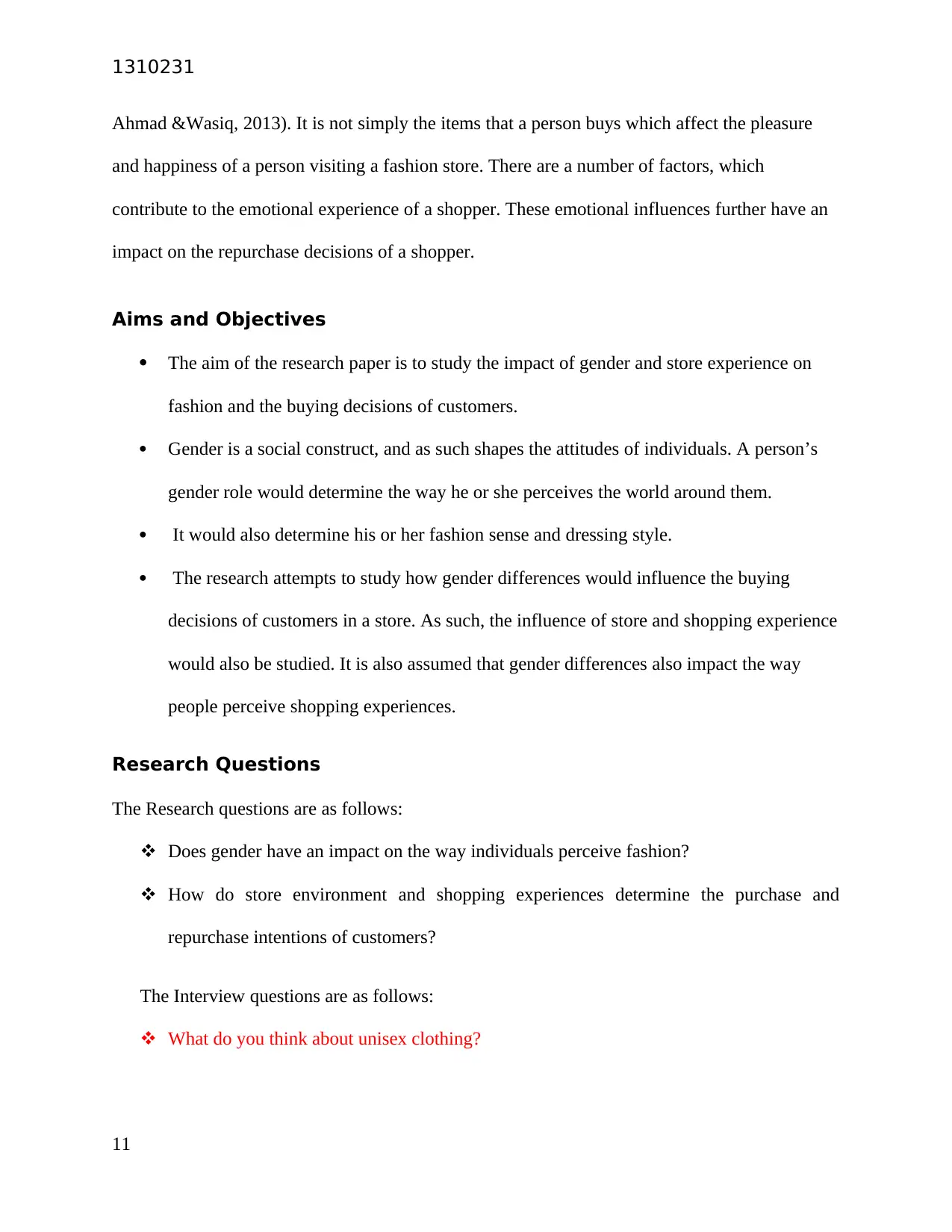
1310231
Ahmad &Wasiq, 2013). It is not simply the items that a person buys which affect the pleasure
and happiness of a person visiting a fashion store. There are a number of factors, which
contribute to the emotional experience of a shopper. These emotional influences further have an
impact on the repurchase decisions of a shopper.
Aims and Objectives
The aim of the research paper is to study the impact of gender and store experience on
fashion and the buying decisions of customers.
Gender is a social construct, and as such shapes the attitudes of individuals. A person’s
gender role would determine the way he or she perceives the world around them.
It would also determine his or her fashion sense and dressing style.
The research attempts to study how gender differences would influence the buying
decisions of customers in a store. As such, the influence of store and shopping experience
would also be studied. It is also assumed that gender differences also impact the way
people perceive shopping experiences.
Research Questions
The Research questions are as follows:
Does gender have an impact on the way individuals perceive fashion?
How do store environment and shopping experiences determine the purchase and
repurchase intentions of customers?
The Interview questions are as follows:
What do you think about unisex clothing?
11
Ahmad &Wasiq, 2013). It is not simply the items that a person buys which affect the pleasure
and happiness of a person visiting a fashion store. There are a number of factors, which
contribute to the emotional experience of a shopper. These emotional influences further have an
impact on the repurchase decisions of a shopper.
Aims and Objectives
The aim of the research paper is to study the impact of gender and store experience on
fashion and the buying decisions of customers.
Gender is a social construct, and as such shapes the attitudes of individuals. A person’s
gender role would determine the way he or she perceives the world around them.
It would also determine his or her fashion sense and dressing style.
The research attempts to study how gender differences would influence the buying
decisions of customers in a store. As such, the influence of store and shopping experience
would also be studied. It is also assumed that gender differences also impact the way
people perceive shopping experiences.
Research Questions
The Research questions are as follows:
Does gender have an impact on the way individuals perceive fashion?
How do store environment and shopping experiences determine the purchase and
repurchase intentions of customers?
The Interview questions are as follows:
What do you think about unisex clothing?
11
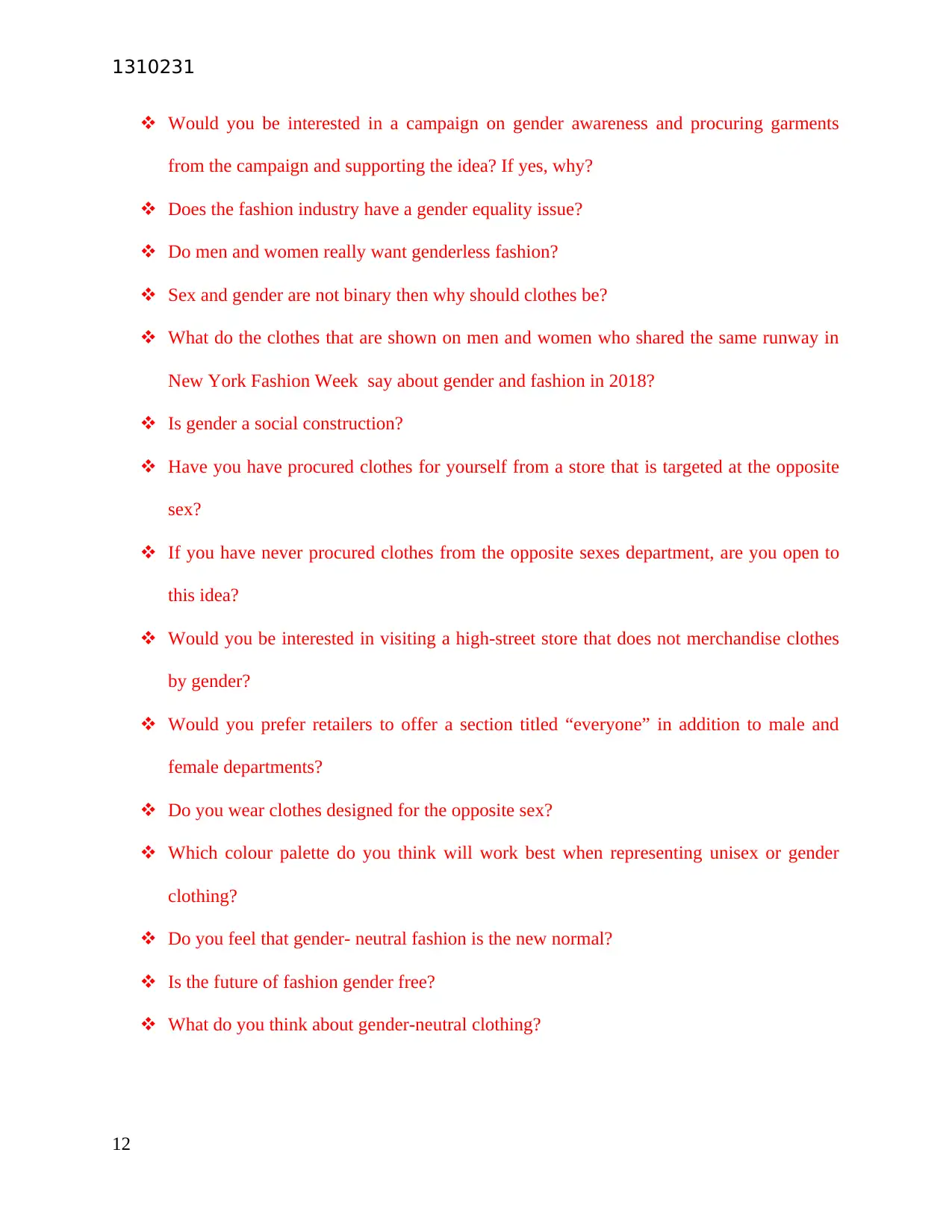
1310231
Would you be interested in a campaign on gender awareness and procuring garments
from the campaign and supporting the idea? If yes, why?
Does the fashion industry have a gender equality issue?
Do men and women really want genderless fashion?
Sex and gender are not binary then why should clothes be?
What do the clothes that are shown on men and women who shared the same runway in
New York Fashion Week say about gender and fashion in 2018?
Is gender a social construction?
Have you have procured clothes for yourself from a store that is targeted at the opposite
sex?
If you have never procured clothes from the opposite sexes department, are you open to
this idea?
Would you be interested in visiting a high-street store that does not merchandise clothes
by gender?
Would you prefer retailers to offer a section titled “everyone” in addition to male and
female departments?
Do you wear clothes designed for the opposite sex?
Which colour palette do you think will work best when representing unisex or gender
clothing?
Do you feel that gender- neutral fashion is the new normal?
Is the future of fashion gender free?
What do you think about gender-neutral clothing?
12
Would you be interested in a campaign on gender awareness and procuring garments
from the campaign and supporting the idea? If yes, why?
Does the fashion industry have a gender equality issue?
Do men and women really want genderless fashion?
Sex and gender are not binary then why should clothes be?
What do the clothes that are shown on men and women who shared the same runway in
New York Fashion Week say about gender and fashion in 2018?
Is gender a social construction?
Have you have procured clothes for yourself from a store that is targeted at the opposite
sex?
If you have never procured clothes from the opposite sexes department, are you open to
this idea?
Would you be interested in visiting a high-street store that does not merchandise clothes
by gender?
Would you prefer retailers to offer a section titled “everyone” in addition to male and
female departments?
Do you wear clothes designed for the opposite sex?
Which colour palette do you think will work best when representing unisex or gender
clothing?
Do you feel that gender- neutral fashion is the new normal?
Is the future of fashion gender free?
What do you think about gender-neutral clothing?
12
⊘ This is a preview!⊘
Do you want full access?
Subscribe today to unlock all pages.

Trusted by 1+ million students worldwide
1 out of 25
Related Documents
Your All-in-One AI-Powered Toolkit for Academic Success.
+13062052269
info@desklib.com
Available 24*7 on WhatsApp / Email
![[object Object]](/_next/static/media/star-bottom.7253800d.svg)
Unlock your academic potential
Copyright © 2020–2025 A2Z Services. All Rights Reserved. Developed and managed by ZUCOL.




